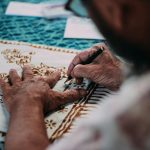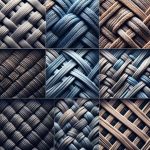Do you ever wonder what the selvage is when reading a sewing pattern or working with fabric? Selvage is the self-finished edge of fabric that runs parallel to the warp (lengthwise) threads. It’s important to understand the selvage because it can affect the way your project turns out.
In this article, you will learn about the definition and importance of selvage in sewing, how to identify it, and how to use it in your sewing projects.
Understanding the grainline is essential to understanding the selvage. The grainline is the direction in which the fabric is woven and is determined by the warp threads. The selvage runs parallel to the grainline and is a tightly woven edge that prevents the fabric from fraying.
When you use the selvage in your sewing projects, you are ensuring that your project will be sturdy and durable. So, let’s dive into the world of selvage and see how it can improve your sewing skills!
Table of Contents
Definition and Importance of Selvage in Sewing
The selvage is the tightly woven edge of the fabric that runs parallel to the grain line, and it’s crucial to keep it intact when cutting and sewing to ensure the fabric doesn’t fray. It’s easy to overlook the selvage when starting a sewing project, but it’s an essential part of the fabric that can make a big difference in the final product’s quality.
The selvage is where the weft threads loop back at the end of each row, creating a tight, sturdy edge that won’t unravel. If you’re working with a fabric that has a distinct pattern or design, the selvage often includes important information, such as the manufacturer’s name, fabric content, and washing instructions.
If you accidentally cut off the selvage, it can be challenging to figure out which way the fabric should be oriented, which can result in a botched project. Even if the fabric doesn’t have a pattern, the selvage is still an important guide for cutting and sewing, as it ensures that the pieces are cut straight and on-grain.
In addition to providing guidance for cutting and sewing, the selvage can also add a decorative touch to a project. Some sewists incorporate the selvage into the design, using it as a decorative edge or incorporating it into the seams. It’s a unique way to add interest to a project and showcase the fabric’s design.
Overall, the selvage is an important part of the fabric that should be respected and utilized when sewing.
Understanding the Grainline
Get ready to feel confident and empowered with your sewing projects by understanding how the grainline affects the final outcome of your garment. The grainline refers to the direction of the threads in the fabric, and it’s essential to take into account when laying out and cutting your pattern pieces.
The way the fabric drapes and stretches is determined by the grainline, which ultimately affects how the finished garment will look and feel. To ensure that your garment hangs properly and fits well, it’s crucial to follow the grainline indicated on your pattern. The grainline is usually represented by an arrow on the pattern piece, indicating the direction of the threads.
Cutting against the grainline can cause your garment to twist or hang awkwardly, so it’s best to avoid this mistake. Taking the time to understand and follow the grainline will result in a more professional-looking finished product that you can be proud of.
In addition to affecting the fit and drape of your garment, the grainline can also impact the longevity of your sewing project. If you cut your fabric against the grainline, it can cause the fabric to fray or weaken over time. This can lead to holes or tears in your garment, which will ultimately shorten its lifespan.
By paying attention to the grainline and cutting your fabric accordingly, you can ensure that your sewing projects will stand the test of time.
Identifying Selvage in Fabric
You’ll be amazed at how much easier it is to work with fabric once you know how to identify the selvage. The selvage is the tightly woven edge of a fabric that runs parallel to the grainline. It’s usually finished with a different color or texture than the rest of the fabric and is often printed with the manufacturer’s information.
Identifying the selvage is important because it helps you determine the grainline of the fabric. The grainline is the direction in which the fabric fibers run, and it’s important to follow this when cutting and sewing to ensure that your finished project hangs and drapes correctly. The selvage also helps prevent fraying and unraveling of the fabric edges.
To identify the selvage, look for the finished edge of the fabric that’s usually located on both sides of the width. It’ll be a different color or texture than the rest of the fabric and may be printed with information such as the fabric content, manufacturer, and care instructions.
Make sure to cut off the selvage before sewing as it can cause bulk and stiffness in your finished project.
Using Selvage in Sewing Projects
When sewing, don’t overlook the selvage of your fabric! It can be a great design element, adding a pop of color or texture to your project.
Plus, it can also be used as a guide for cutting and measuring, ensuring your fabric stays in line and your project turns out just right.
So next time you’re sewing, take a closer look at your selvage and see how you can incorporate it into your project.
Selvage as a Design Element
Selvage isn’t just a functional aspect of sewing, it can also be a stylish design element to enhance your creations. With its distinctive, often patterned edge, selvage can add an interesting touch to any project.
You can incorporate selvage into your designs in a number of ways, such as using it as a decorative trim or highlighting it by leaving it exposed. One way to use selvage as a design element is to create a bold border or edge on your project. This can be especially effective on garments, such as skirts or jackets, where the selvage can provide a unique finishing touch.
Another option is to use selvage in unexpected ways, such as incorporating it into pockets or using it to create a striking contrast against another fabric. No matter how you choose to use it, selvage is a versatile and creative way to add interest and style to your sewing projects.
Selvage as a Guide for Cutting and Measuring
By using the edge of the fabric with the pattern as a guide, you can ensure that your cuts and measurements are accurate and aligned. This is because the selvage is tightly woven and less likely to stretch or distort, making it the ideal reference point for cutting and measuring your fabric.
Here are some tips to help you make the most out of the selvage:
-
Use the selvage as a guide for cutting straight lines. Simply align your ruler or measuring tape with the edge of the selvage and cut along the line.
-
Measure from the selvage to ensure that your pieces are the same length. This is especially important when sewing garments, as uneven hemlines or sleeve lengths can ruin the fit and appearance of your project.
-
Mark your fabric using the selvage as a reference point. For example, if you need to add darts or pleats to your fabric, mark the location using the selvage as a starting point.
-
Use the selvage as a guide for grainline placement. The grainline is the direction of the fabric’s weave, and it’s important to align your pattern pieces with the grainline to ensure a good fit and drape.
-
Keep the selvage intact until you’re ready to start sewing. This will help you avoid confusion about which direction the fabric should be placed, and it will also prevent fraying and unraveling along the edges.
By following these tips, you can take advantage of the selvage as a reliable guide for cutting and measuring your fabric. This will help you achieve accurate and professional-looking results in your sewing projects.
Tips for Working with Selvage
To make the most of your fabric, you’ll want to utilize the selvage edge by incorporating it into your design. One tip for working with selvage is to use it as a decorative element. You can fold it over to create a border or trim on your project, or even use it as piping.
Another tip is to always check the width of the selvage before cutting your fabric. Some selvages may be wider or narrower than others, which can affect the overall measurements of your project. By measuring the selvage and taking it into account during the cutting process, you can ensure that your project turns out the way you intended.
Lastly, when working with selvage, it’s important to handle it with care. Selvage edges are more tightly woven than the rest of the fabric, which can cause them to fray or unravel if mishandled. Be sure to use sharp scissors or a rotary cutter to cut along the selvage edge, and avoid pulling or tugging on it while sewing.
By following these tips, you can make the most of the selvage edge and create beautiful, well-made projects.
Common Misconceptions about Selvage
You may have heard some misconceptions about the edge of your fabric that runs parallel to the lengthwise grain, but it’s important to know the truth about selvage.
One common misconception is that selvage is not usable for sewing projects. This couldn’t be further from the truth! In fact, selvage is often used in sewing projects as a decorative element or to add stability to seams.
Another misconception is that all selvages are created equal. While most selvages are made to prevent fraying and add stability to the fabric, some selvages may be wider or have a different texture than others. It’s important to inspect the selvage of your fabric before starting a project to ensure that it will work well for your specific needs.
A final misconception is that selvage can be cut off without any consequences. While it may be tempting to cut off the selvage to have a clean edge, it’s important to keep in mind that the selvage adds stability to the fabric and cutting it off may cause the fabric to fray or distort. Instead, consider incorporating the selvage into your project or using a seam finish that will keep the selvage intact.
- Tetron Fabric for Marine Applications: Durability and Use Cases - June 18, 2025
- Tetron Fabric for Outdoor Furniture: Weather Resistance and Care - June 18, 2025
- Tetron Fabric for Wall Coverings: Style and Application Tips - June 18, 2025



